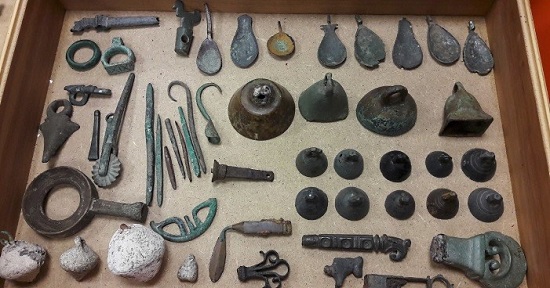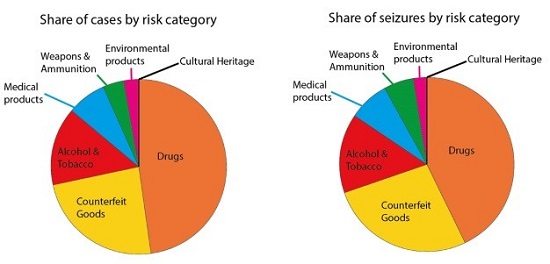from the IADAA Newsletter
March 7, 2019 – The World Customs Organisation published its latest report into illicit trade in December. The size of any problem can be assessed under four variables: the number of cases, the number of seizures, the volume of seized material and the value of that material. As IADAA has always argued, by any of these variables, Cultural Heritage – of which Antiquities form only a part – barely registers as a problem area among the risk categories listed.
IADAA has conducted its own potted analysis of the 205-page WCO report as a user-friendly guide to the findings, which includes a direct link to the original report for independent verification purposes.
Risk category comparisons and share of seizures by risk category. Photo: IADAA.
As the analysis and the original report show, at one end of the scale Drugs-related cases make up 47.7% of global trafficking; at the other, Cultural Heritage represents 0.2%. Likewise, when it comes to the number of seizures, Drugs accounts for 42.8%, while Cultural Heritage covers 0.2%. The next smallest category in each of these measures is Environmental Products, which accounts for 2.7% and 2.3% respectively. Even these figures are, respectively, 16 times and 14 times larger than the Cultural Heritage measures.
All of the above also needs to be taken in the context of a more proficient international Customs operation that is better able to cope with Cultural Heritage than ever before, according to the WCO, with twice as many countries submitting data as the previous year (25 compared with 13). Despite this, the number of Cultural Heritage cases has slightly fallen, while the number of seizures has only risen from 158 to 167. Compare that to over 40,000 cases and over 43,000 seizures involving Drugs.
An exact assessment of values is not possible because the information is simply not available – although the report estimates the global illicit trade in Environmental Products to be worth between $91 billion and $250 billion. What is clear, however, is that, Cultural Heritage aside, the value of material seized in every other category must be worth at least in the hundreds of millions of dollars if not more.
When it comes to Cultural Heritage, although the number of cases has fallen and the number of seizures has only risen slightly, the number of items seized has increased from 9,931 to 14,754. These include all types of items across the range of categories covered by Cultural Heritage, from books & manuscripts and paintings to household items, jewellery, weapons, engravings and lithographs, as well as film and sound archives, the last of which makes up a very large number of items seized (3,169, according to the WCO report). Antiquities make up 8725 items, a rise from 8005 in 2016.
Many of the illustrations from the 2017 WCO Illicit Trade Report show mainly very low value items. None of these items are covered by the UNESCO 1970 Convention. Photo: IADAA / WCO.
It is reasonable to assume that the WCO will include images of its most important seizures in the report. If so, then the quality of what has been seized is generally very low grade indeed. Bizarrely, it includes a haul of 2919 long playing records seized in transit from the Netherlands to Turkey. As it is not illegal to export LPs from the Netherlands, it is not clear why they were seized.
The overwhelming majority of Antiquities items pictured are broken potsherds and coins – items that would not be covered by the UNESCO Convention. As the IADAA analysis points out: “The only items of significant value pictured in the report have nothing to do with customs work, nor were they seized, but voluntarily returned when their owners/holders discovered that they might be tainted, so it is misleading for them to have been included”.
In summary, although this is not a scientific assessment, if the images used to illustrate the quality of antiquities seizures in the WCO report are anything to go by, a generous over-estimate of the value of items seized would be around $500,000. To put that in context, that is around 0.001% of the value of the next smallest category at most.
If Customs are much more efficient and twice the number of countries – from all regions – are submitting data, where is the massive haul of cases and seizures one should expect if Cultural Heritage trafficking is the problem that anti-trade campaigners, politicians and others would have it? As the WCO itself concluded in its 2016 report: “As Customs officers become increasingly proficient in seizing both large and small shipments of cultural objects, the data can suggest that illicit trade is on the rise when, in reality, levels of trafficking may be holding constant or even decreasing.”
This also gives the lie to Interpol’s claim (as published on its Works of Art Crime home page) that “The black market in works of art is becoming as lucrative as those for drugs, weapons and counterfeit goods” – a claim it confusingly contradicted on the FAQs it provided via the same page. This is important because the European Commission and Parliament, among others, have used this headline claim by Interpol as evidence justifying the introduction of stringent new import licensing regulations in the EU.
IADAA was able to demonstrate during the consultation and negotiations over the import licensing proposals that even the European Commission’s own researches failed to find any problem at all, yet the Commission insisted on pressing ahead with unnecessary and damaging legislation.
This summary analysis is being forwarded to those conducting the follow-up study on behalf of the European Commission after it expressed doubts about its original research. Hopefully these WCO statistics and other findings will make a difference.
For more information on the International Association of Dealers in Ancient Art go to the IADAA website.
The 2017 WCO Illicit Trade Report is available online.
You can read IADAA’s evaluation of the report here.
More articles on cultural property issues are available in our respective archive section.





